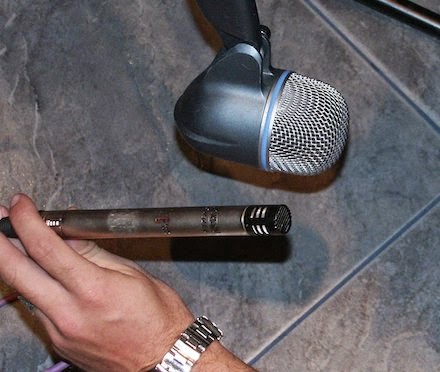A big problem when recording drums is phase cancellation because there are so many mics normally used. Here's an excerpt from the 3rd edition of The Recording Engineer's Handbook that will show you a foolproof way of avoiding electronic phase cancellation on your kit.
"One of the things that you’ll see frequently throughout this book are references to a phenomena known as “phase cancellation.” One of the most overlooked aspects of recording is how microphones interact with each other, both acoustically and electrically.
The reason why this is a concern is that it only takes a single out-of-phase mic to destroy the sound of a multi-miked instrument like a drum kit, and if not corrected, the sound may never be able to be fixed.
There are two types of phase cancellation; electronic and acoustic. Most of the phase problems we’ll discuss in the book are acoustic in nature, but there’s also an instance of electronic phase cancellation that you should know about as well. Keep in mind that this has nothing to do with mic placement as it’s strictly an electronic problem that never shows up until multiple mics are used.
Electronic phase problems are almost always caused by a cable in the studio (usually a mic cable) that’s been mis-wired during an install, repaired incorrectly, or originally wired incorrectly from the factory (which is rare). The polarity check is used mainly to be sure that all mics are pushing and pulling the same way and to check for mis-wired cables, which happen more than you’d think even in some of the best facilities in the world.
Checking The Polarity
Checking microphone polarity should be one of the first things that an engineer does after all the mics are wired up and tested, especially if you’re working in an unfamiliar studio. This is especially true before a tracking session where a lot of mics will be used, since having just one mic out of phase can cause an uncorrectable sonic problem that will most likely haunt that recording forever. A session that is in-phase will sound bigger and punchier while just one out-of-phase mic can make the entire mix sound tiny and weak.
For this test we’ll be using the phase switch on the mic preamp, DAW interface or console, since it’s really a polarity switch that changes the phase by 180 degrees at all frequencies by swapping pins 2 and 3 of a balanced microphone line. Here’s the test:
1. After the mics are set up, wired and checked, but not necessarily placed, pick one mic that can be easily moved. This can be a scratch vocal mic, a hat mic, or a guitar mic; it doesn’t matter as long as it works, sounds good to begin with (meaning that it’s not defective) and can move next to the farthest mic used in the session. This mic will become our “gold standard.”
2. With the gold standard mic in hand, move it next to the kick drum mic (or any other mic that you wish to test for that matter). Place both mics together so the capsules touch and speak into them from about a foot away (the distance isn’t critical - see the figure on the left).
3. Bring up the faders on both mics so the audio level (not the fader position) is equal on both. You can check this by making sure that the level meters read the same.
4. Flip the phase of the mic under test (in this case, the kick mic) and choose the position that gives you the most low end.
5. Repeat with all the other mics used on the session.
Remember, you’re not flipping the phase of the gold standard mic; only the one that you’re testing."
To read additional excerpts from The Recording Engineer's Handbook 3rd edition and my other books, go to the excerpts section of bobbyowsinski.com.
----------------------------------



1 comment:
As a youngster Going enjoying your drummer a lot more than listening to your vocalist when they enjoyed their audio. The particular appear in this guitar are often very hippy and can bring you with your legs.
Post a Comment